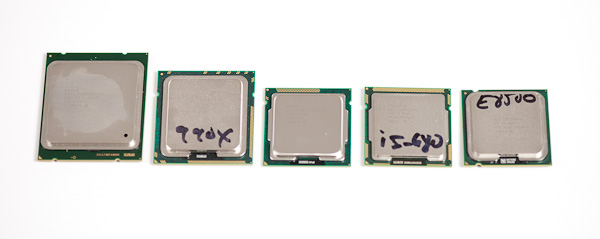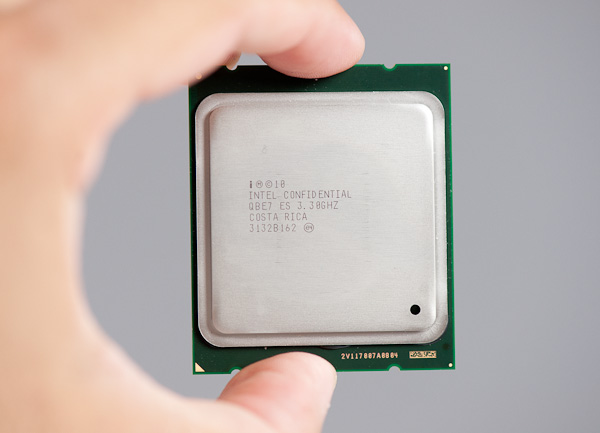Intel Core i7 3960X (Sandy Bridge E) Review: Keeping the High End Alive
by Anand Lal Shimpi on November 14, 2011 3:01 AM EST- Posted in
- CPUs
- Intel
- Core i7
- Sandy Bridge
- Sandy Bridge E
Final Words
There are two aspects of today's launch that bother me: the lack of Quick Sync and the chipset. The former is easy to understand. Sandy Bridge E is supposed to be a no-compromise, ultra high-end desktop solution. The lack of an on-die GPU with Quick Sync support means you have to inherently compromise in adopting the platform. I'm not sure what sort of a solution Intel could've come to (I wouldn't want to give up a pair of cores for a GPU+QuickSync) but I don't like performance/functionality tradeoffs with this class of product. Secondly, while I'm not a SAS user, I would've at least appreciated some more 6Gbps SATA ports on the chipset. Native USB 3.0 support would've been nice as well. Instead what we got was effectively a 6-series chipset with a new name. As Intel's flagship chipset, the X79 falls short.

From left to right: Intel Core i7 (SNB-E), Core i7 (Gulftown), Core i5 (SNB), Core i5 (Clarkdale), Core 2 Duo
LGA-2011, 1366, 1155, 1156, 775
The vast majority of desktop users, even enthusiast-class users, will likely have no need for Sandy Bridge E. The Core i7 3960X may be the world's fastest desktop CPU, but it really requires a heavily threaded workload to prove it. What the 3960X doesn't do is make your gaming experience any better or speed up the majority of desktop applications. The 3960X won't be any slower than the fastest Sandy Bridge CPUs, but it won't be tremendously faster either. The desktop market is clearly well served by Intel's LGA-1155 platform (and its lineage); LGA-2011 is simply a platform for users who need a true powerhouse.
There are no surprises there, we came to the same conclusion when we reviewed Intel's first 6-core CPU last year. If you do happen to have a heavily threaded workload that needs the absolute best performance, the Core i7 3960X can deliver. In our most thread heavy tests the 3960X had no problems outpacing the Core i7 2600K by over 50%. If your livelihood depends on it, the 3960X is worth its entry fee. I suspect for those same workloads, the 3930K will be a good balance of price/performance despite having a smaller L3 cache. I'm not terribly interested in next year's Core i7 3820. Its point is obviously for those users who need the memory bandwidth or PCIe lanes of SNB-E, but don't need more than four cores. I would've liked to have seen a value 6-core offering instead, but I guess with a 435mm2 die size it's a tough sell for Intel management.
Of course compute isn't the only advantage of the Sandy Bridge E platform. With eight DIMM slots on most high end LGA-2011 motherboards you'll be able to throw tons of memory at your system if you need it without having to shop for workstation motherboards with fewer frills.
As for the future of the platform, Intel has already begun talking about Ivy Bridge E. If it follows the pattern set for Ivy Bridge on LGA-1155, IVB-E should be a drop in replacement for LGA-2011 motherboards. The biggest issue there is timing. Ivy will arrive for the mainstream LGA-1155 platforms around the middle of 2012. At earliest, I don't know that we'd see it for LGA-2011 until the end of next year, or perhaps even early 2013 given the late launch of SNB-E. This seems to be the long-term downside to these ultra high-end desktop platforms these days: you end up on a delayed release cadence for each tick/tock on the roadmap. If you've always got to have the latest and greatest, this may prove to be frustrating. Based on what we know of Ivy Bridge however, I suspect that if you're using all six of these cores in SNB-E that you'll wish you had IVB-E sooner, but won't be tempted away from the platform by a quad-core Ivy Bridge on LGA-1155.
I do worry about the long term viability of the ultra high-end desktop platform. As we showed here, some of the gains in threaded apps exceed 50% over a standard Sandy Bridge. That's tangible performance to those who can use it. With the growth in cloud computing it's clear there's demand for these types of chips in servers. I just hope Intel continues to offer a version for desktop users as well.











163 Comments
View All Comments
xpclient - Monday, November 14, 2011 - link
I read Intel is not going to release AHCI/SATA/Matrix RAID drivers for 32-bit Windows XP for X79. Why??? Without AHCI, performance is going not going to be optimal. For those that dual boot with Windows 7, this means changing the settings from AHCI to IDE every time you boot into XP.Rick83 - Monday, November 14, 2011 - link
And I heard that USB 3 had no drivers for my Win95 D either!B3an - Monday, November 14, 2011 - link
Because no one in there right mind would buy this high-end platform then use a decade old POS operating system. Waste of Intels time to support it and XP needs to die already.XP will take little advantage of SSD's or even new HDD's properly, some drives wont even work at all on it, and it lacks the same level of support and performance for CPU features and multiple cores that Win7 has. If you really need to run some old software just use XP mode in Win 7 or use VM software.
xpclient - Monday, November 14, 2011 - link
Are you not aware of multi-core benchmarks? http://www.infoworld.com/t/platforms/generation-ga... Windows 7 does not perform faster than XP until you reach eight cores or higher.Peskarik - Monday, November 14, 2011 - link
"Just as with previous architectures, installing fewer DIMMs is possible, it simply reduces the peak available memory bandwidth."So, I have:
Asus P8Z68-V Pro/Gen3 motherboard
Intel Core i7 2600K
Corsair Vengeance Red, 2x4GB, DDR3-1600, CL9@1.5V
When I am in BIOS the memory is set to 1333Mhz, and I had to manually set it to 1600, though I am not sure whether it actually runs at this speed (how can I check?).
Does the above sentence from the article mean that with 8GB RAM I do not have full memory bandwidth and that if I install 16GB RAM (I have 4 slots) then I have full 1600Mhz automatically?
kr1s69 - Monday, November 14, 2011 - link
Sandy Bridge E is quad channel and so needs 4 DIMM's to obtain the peak bandwidth. Your Sandy Bridge system is dual channel and so you need 2 DIMM's to obtain the peak bandwidth. This is what you currently have installed, so no need to worry.The statement you quoted is basically saying this motherboard would boot with less than 4 DIMM's installed, that is all.
Sandy Bridge defaults to 1333Mhz but you can change this in the BIOS to 1600Mhz as you have done. You can download CPU-Z to confirm what speed your RAM is set to.
piroroadkill - Monday, November 14, 2011 - link
Set the O/C Profile to X.M.P.This uses the eXtreme Memory Profile provided by your RAM. Basically, standard SPD ratings don't go as high as 1600. XMP is required for this, it's a custom Intel extension to SPD.
piroroadkill - Monday, November 14, 2011 - link
Although it's supposed to work, in my experience I had to set my RAM to DDR3-1600 anyway. Ho hum.lukarak - Monday, November 14, 2011 - link
This is not a great update. I wonder if 2011 will be the socket for ivy bridge E. If that's the case, it could be a good buy for somebody transitioning from an older system.dlitem - Monday, November 14, 2011 - link
There were some rumors / news circulating earlier that VT-d is bugged. Is that actually the case? SB-E is The workstation platform and losing VT-d is kind of a shame, as there actually are people who might have benefited from it.Also, a lot of us are still running our trusty 3 year old Quad-Bloomfields that have served us so well, so including one LGA1366 Quad-core would have be a really nice thing.